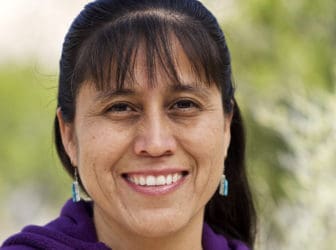COMMENTARY: New Mexico is a beautiful state. One of the aspects that makes our state so beautiful is the presence of the 22 tribal nations who are indigenous to the Land of Enchantment. If we want to continue to thrive as a state, we must support the tribal communities in the education they desire for their children.

Courtesy photo
Trisha Moquino
New Mexico Public Education Department 2017 web data shows that 44 percent of American Indian kindergarteners are proficient in pre-reading skills. But by the time they reach the fourth grade, only 14 percent of them are proficient in reading.
If early childhood education works, why have these scores persisted for more than 10 years? The fact that they have not significantly improved illustrates that early childhood efforts must be done with tribes, not for tribes.
Historically, the state’s early childhood and other educational efforts did to, or did for — rather than doing with — tribal communities. They must be genuinely inclusive of the 22 tribal communities in the State of New Mexico, acknowledging the tribal languages, beliefs and values about children and their well-being.
These are steeped in traditions that have been around long before colonization occurred. And early childhood education and the boarding school era — along with other colonization practices — have historically devalued these practices and beliefs in New Mexican tribal communities.
Today, in many tribal communities, beliefs about caring and raising children are embedded in the tribes’ languages. They exist with a particular worldview.
Each tribe’s worldview holds the knowledge and ways in which a tribe sees its children. Perhaps New Mexico’s early childhood institutions should consider working with tribes to ask them what they think is best for their children.
One of New Mexico’s strengths is its linguistic diversity. Among the state’s 22 tribes, nine indigenous languages are spoken. Perhaps New Mexico early childhood education — and education in general — should focus on the success of dual-language education, which has been the only form of education to close the “achievement gap.”
Children who participate in quality dual-language education from early childhood through middle and high school eventually outperform their monolingual peers by the time they are in eighth grade, as demonstrated in the research of Wayne Thomas and Virginia Collier, education professors at George Mason University.
In the next two years, New Mexico early childhood advocates should focus their efforts on the work of the Walatowa Head Start, the Keres Children’s Learning Center, and the Native American Community Academy Elementary. Those programs provide a holistic approach that is inclusive of the tribes and languages they serve.
New Mexico early childhood efforts need to stop the one-size-fits-all approach and find a way to build on the strengths of our tribal communities. Education as it exists today is deficit-based. We must make it an education that focuses on the strengths of our tribal communities, ultimately supporting tribes in their right to education sovereignty.
Taking these steps will be time-consuming and expensive, but if we take the time to do it right, we will start to see the needle move for the benefit and beauty of all of New Mexico.
Trisha Moquino is co-founder and educational director of the Keres Children’s Learning Center on the Pueblo de Cochiti reservation, where she was raised (along with the Kewa Pueblo). It was while working as a public school teacher in 2006 that Moquino, a Stanford University graduate, decided she was perpetuating an educational system that didn’t work for many indigenous children. She envisioned a school that would support the Cochiti language and culture. KCLC, a Montessori-based program, is the result of that vision. Agree with her opinion? Disagree? NMPolitics.net welcomes your views. Learn about submitting your own commentary here.